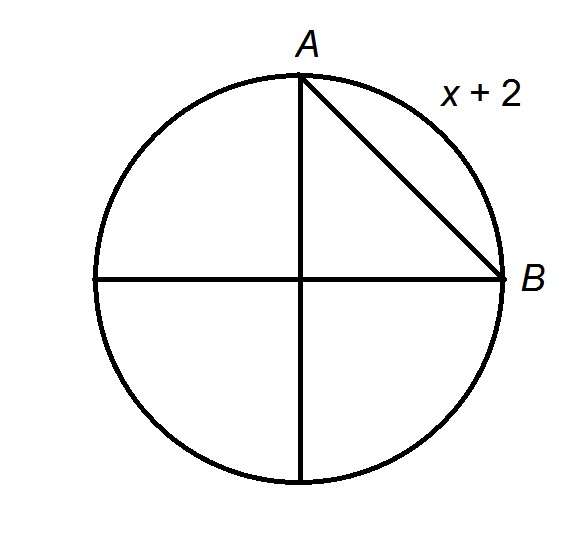GMAT Quantitative Reasoning
Help Questions
GMAT Quantitative › GMAT Quantitative Reasoning

The above figure shows a rhombus 
Explanation
Construct the other diagonal of the rhombus, which, along with the first one, form a pair of mutual perpendicular bisectors.

By the Pythagorean Theorem,
The rhombus can be seen as the composite of four congruent right triangles, each with legs 10 and 

Two angles of an isosceles triangle measure 


Explanation
In an isosceles triangle, at least two angles measure the same. Therefore, one of three things happens:
Case 1: The two given angles have the same measure.
The angle measures are 
Case 2: The third angle has measure 
Then, since the sum of the angle measures is 180,
as before
Case 3: The third angle has measure
as before.
Thus, the only possible value of 

This triangle cannot exist.
Explanation
A scalene triangle has three sides of different lengths, so we are looking for three distinct prime integers whose sum is 47.
There are ten ways to add three distinct primes to yield sum 47:
By the Triangle Inequality, the sum of the lengths of the shortest two sides must exceed that of the greatest. We can therefore eliminate all but four:
The greatest possible length of the longest side is 23.

Note: Figure NOT drawn to scale.
Refer to the above diagram. Give the area of Quadrilateral 
The correct answer is not among the other choices.
Explanation
Apply the Pythagorean Theorem twice here.
The quadrilateral is a composite of two right triangles, each of whose area is half the product of its legs:
Area of 
Area of 
Add:
The arc 



Explanation
The figure referenced is below.

The arc is 

The radius is this circumference divided by 




Find the volume of a cylinder whose height is 

Explanation
To find the volume of a cylinder, you must use the following equation:
Thus,
The average of 10, 25, and 70 is 10 more than the average of 15, 30, and x. What is the missing number?
Explanation
The average of 10, 25, and 70 is 35:
So the average of 15, 30, and the unknown number is 25 or, 10 less than the average of 10, 25, and 70 (= 35)
so
In the 


Explanation



What is the domain of 
all real numbers
Explanation
The domain of the function specifies the values that 



The circle in the above diagram has center 
Statement 1: The circle has circumference 
Statement 2:
BOTH statements TOGETHER are sufficient to answer the question, but NEITHER statement ALONE is sufficient to answer the question.
Statement 1 ALONE is sufficient to answer the question, but Statement 2 ALONE is NOT sufficient to answer the question.
BOTH statements TOGETHER are insufficient to answer the question.
EITHER statement ALONE is sufficient to answer the question.
Statement 2 ALONE is sufficient to answer the question, but Statement 1 ALONE is NOT sufficient to answer the question.
Explanation
To find the area of a sector of a circle, we need a way to find the area of the circle and a way to find the central angle of the sector.
Statement 1 alone gives us the circumference; this can be divided by 



Statement 2 alone asserts that 


Assume both statements are true. The radius is 

























































































